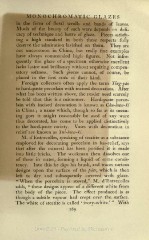Page 331 - Oriental Series Japan and China, Brinkly
P. 331
MONOCHROMATIC GLAZES
in the form of floral scrolls and bands of leaves.
Much of the beauty of such ware depends on deli-
cacy of technique and lustre of glaze. Pieces satisfy-
ing a high standard in both these respects fully
deserve the admiration lavished on them. They are
not uncommon in China, but really fine examples
have always commanded high figures. Not infre-
quently the glaze of a specimen otherwise excellent
lacks lustre and brilliancy without acquiring compen-
satory softness. Such pieces cannot, of course, be
placed in the first rank of their kind.
Foreign collectors often apply the term Ting-yao
to hard-paste porcelain with incised decoration. After
what has been written above, the reader need scarcely
be told that this is a misnomer. Hard-paste porce-
lain with incised decoration is known as Chu-hwa-ki
in China a name which, though so far as its mean-
;
ing goes it might reasonably be used of any ware
thus decorated, has come to be applied distinctively
to the hard-paste variety. Vases with decoration in
relief are known as Tui-hwa-ki.
M. d'Entrecolles, speaking of steatite as a substance
employed for decorating porcelain in bas-relief, says
that after the mineral has been purified it is made
into little bricks. The workman then dissolves one
of these in water, forming a liquid of some consis-
tency. Into this he dips his brush, and traces various
designs upon the surface of the pdtey which is then
left to dry and subsequently covered with glaze.
"When the porcelain is stoved," M. d'Entrecolles
adds, " these designs appear of a different white from
the body of the piece. The effect produced is as
though a subtile vapour had crept over the surface.
The white of steatite ' ' With
is called ivory-white.'
269

